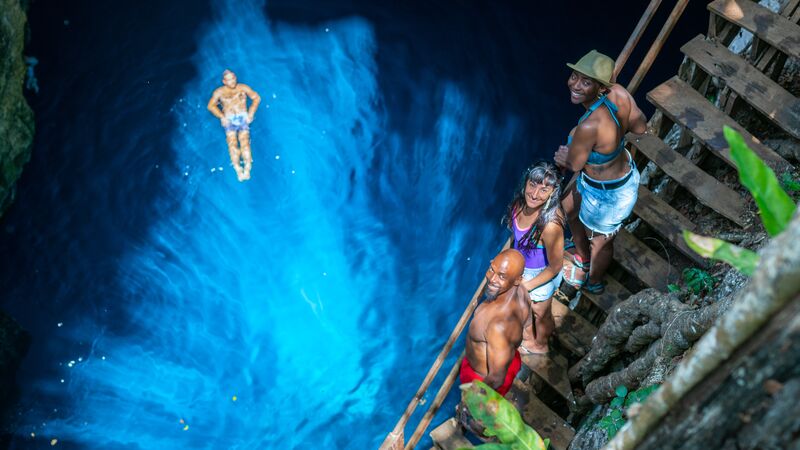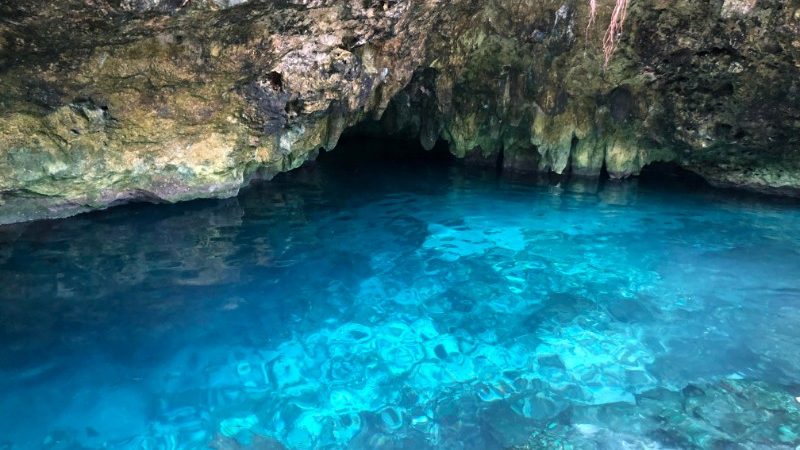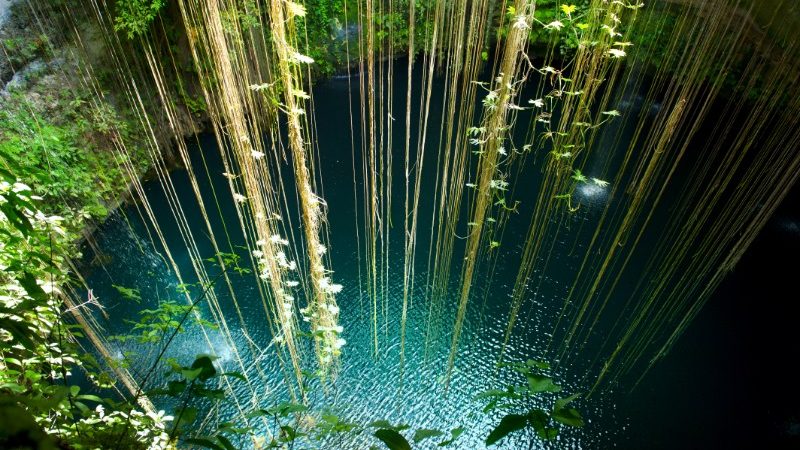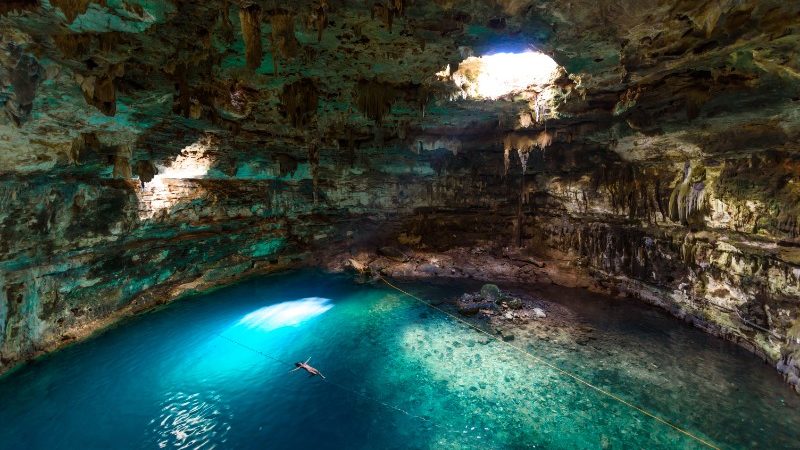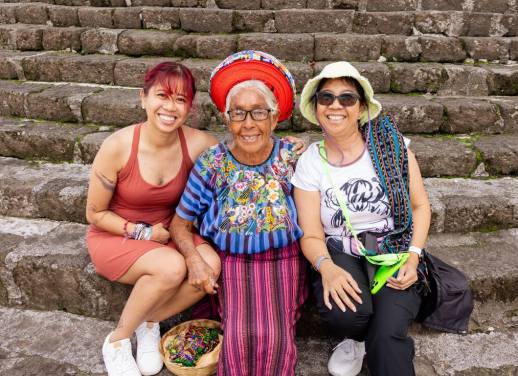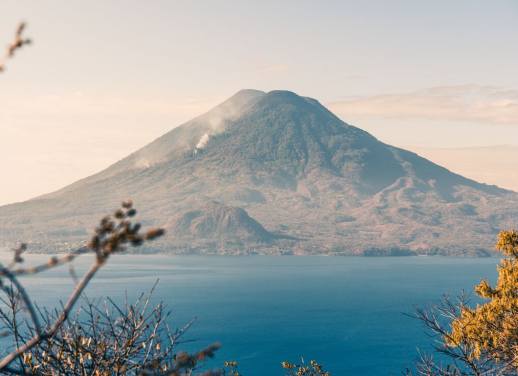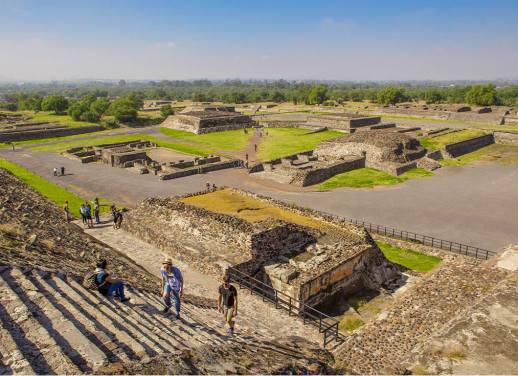UPDATED: This blog was originally published in December 2017.
Cenotes are almost as big a deal in the Yucatán as the beaches.
We had no idea when we first landed in Tulum but the manager at our hotel – Coco, a self-professed Mexican Chola from LA – kindly gave us the lowdown when we arrived. She’d point her long manicured fingernails at the map in a casual way, then suddenly get excited at the idea of all the cenotes. She explained that they’re all connected, since the world’s longest underground river flows deep beneath Mexico’s Yucatán Peninsula, and that there’s a bar *in a cenote*, called Clan-Destino.
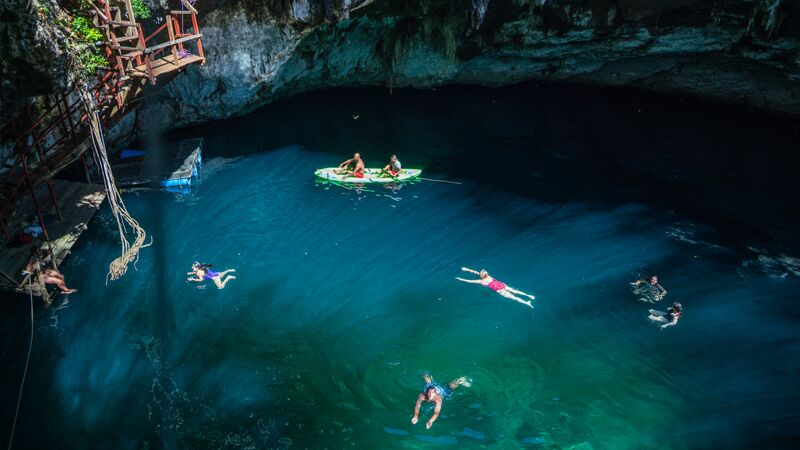
Cenote Suem, just outside Merida.
It’s hard to know where to begin with cenotes; these awe-inspiring underwater sinkholes and caves are created when limestone bedrock collapses and exposes the groundwater below. They vary, with some that have roof openings like a fish mouth, or others being wide, open lakes. There are more than 6000 of them in Mexico’s Yucatán alone, so if you have trouble making decisions and/or a severe case of FOMO like me, you might be overwhelmed.
SPLASH ABOUT IN A CENOTE ON OUR 8-DAY YUCATAN PENINSULA ADVENTURE – DETAILS HERE
Coming from Cancun to Tulum, most travellers tend to take a day trip to more well-known cenotes like Dos Ojos. Coco said Dos Ojos is a bit like a tourist theme park as a result; but if you don’t have a lot of time and don’t mind a quick trip from Cancun, it’s a good contender. She recommended Gran Cenote and the more secluded Cenote Escondido, which was close to where we were staying.
Want to see what a visit to a cenote actually looks like? Check this out:
There are some things you might not realise about cenotes from the picture-perfect and contextless Instagram posts you’ve probably seen (#blessed #Mexico #Cenote can only tell you so much). Cenotes can be hard to get to. You can get ‘Colectivos’ – small buses to some and taxis to others – or, if you’re travelling in group, your leader can help you with transport. The more tourist-friendly cenotes have opening hours and entry fees. And the more secluded cenotes sound ideal in theory, but often involve ‘swim at your own risk’ situations. You can’t swim with creams on your skin, as it can poison fish and sea plants, and the Gran Cenote requires you to take a shower before getting in, you filthy animal.
CHECK OUT OUR FULL RANGE OF ADVENTURES ON THE YUCATAN HERE
So which ones should you visit? It depends on what you’re looking for; colourful fish, snorkelling, diving or just floating around a tranquil body of water for hours on end.
The Gran Cenote is one of the best cenotes in Tulum; located only four kilometres from the Tulum town centre, it’s accessible to boot. The Gran Cenote has snorkelling, diving, turtles, bats flying from the caves, tiny fish, a sandy floor, water lilies and palm trees. It’s surrounded by jungle. Apparently you can also spot toucans that pop out of nowhere in January or February. It’s true, toucan do it.
 For snorkelling and diving, you can’t beat Dos Ojos, El Pit and Carwash (apparently named because people used to – yep – wash their cars there). Dos Ojos is a 15-minute drive from Tulum; it’s one of the largest, known for being up to 118 metres deep! The name – two eyes – refers to the two sections of water, one being the light blue waters for snorkelling (yes please) and then a dark one for diving (yikes!).
For snorkelling and diving, you can’t beat Dos Ojos, El Pit and Carwash (apparently named because people used to – yep – wash their cars there). Dos Ojos is a 15-minute drive from Tulum; it’s one of the largest, known for being up to 118 metres deep! The name – two eyes – refers to the two sections of water, one being the light blue waters for snorkelling (yes please) and then a dark one for diving (yikes!).
RELATED: THE SURPRISES & DELIGHTS OF MEXICO CITY
For the lost paradise idyllic dream cenote you saw on Instagram? That would be the insanely photogenic Ik Kil. This one is very crowded and can be hard to get into, but it is pretty stunning for a giant hole.
And for cenotes with interesting back stories, you can’t go past Dzitnup. Rumour has it, it was discovered after a pig fell into it while being walked by his farmer owner. Its other name is Xkeken, the Mayan word for pig. It’s also known for a stream of light that filters in from the top around noon, but you have to admit that I had you at the pig story.
Set aside a couple of days to explore the cenotes, and prepare for anything (especially rain). I suggest finishing your day sitting at the bar Clan-Destino, drinking a mezcal watermelon margarita like it’s nobody’s business.
Discover the cenotes for yourself on an Intrepid adventure through Mexico.

